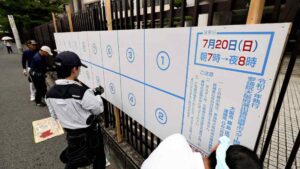
1.The ruling coalition is in danger of losing its majority in the Upper House, a survey by The Asahi Shimbun suggests.The prospect of yet another dramatic shift in the political landscape was based on an early poll by phone and the internet on July 3 and 4 as well as insights gathered by Asahi reporters.
2.About half of the 248 Upper House seats will be up for grabs in the July 20 election.The ruling coalition has 75 seats uncontested, so it only must win 50 to maintain its majority.But the Liberal Democratic Party, the dominant partner in the alliance, looks set to fall well short of the 52 seats it now holds that are being contested.

From left, Komeito’s Tetsuo Saito, the LDP’s Shigeru Ishiba, the DPP’s Yuichiro Tamaki and the CDP’s Yoshihiko Noda.
3.In particular, the LDP is struggling in the 32 single-seat prefectural districts that were key in recent Upper House elections. The Asahi survey shows the LDP leading in only 12 single-seat districts, while opposition candidates are ahead in nine. Eleven seats are too close to call.

4.In contrast, the LDP crushed the opposition three years ago in single-seat districts, winning 28 and losing only four.In the 2019 Upper House election, the LDP won 22 single-seat districts even though the four major opposition parties all supported the same candidate in all the single-seat districts.
5. The Asahi survey shows the LDP winning only about 27 prefectural district seats and 12 or so in the proportional representation portion of the vote.Junior coalition partner Komeito also looks set to fall short of the 14 seats it now holds that are being contested. It could end up winning only 10 seats.

Do you think coalition governments are more effective or more unstable than single-party governments? Why?
6.The main opposition Constitutional Democratic Party of Japan appears likely to add a few seats to the 22 that are being contested. The Democratic Party for the People and the newly emerging right-wing Sanseito party are showing promise in the early stages of the campaign.
7.The DPP could more than double the three seats it has in the proportional representation constituency.While it has only four seats that are being contested, the party set a goal of winning at least 16. It could come close to that figure.
8. Sanseito has only one seat up for grabs, but the Asahi survey shows the party surging to gain about 10 seats. That outcome would make Sanseito the third largest among the opposition parties in terms of seats won in this election.

・Sanseito, a relatively new party, is showing strong early results. What factors might contribute to the rise of new political parties?
9.The other opposition parties, Nippon Ishin (Japan Innovation Party), the Japanese Communist Party and Reiwa Shinsengumi, are struggling to add seats to those they have that are being contested. The Social Democratic Party and the Conservative Party of Japan might gain one seat each in the proportional representation section of the vote.
10.The outcome could still change as half of those contacted said they were undecided about who to vote for in the prefectural districts, while 40 percent said they were undecided about which party to vote for in the proportional representation segment.
11. Numbers for landline and mobile phones randomly generated by computer were called and valid responses were received from 5,560 voters using landline phones and 5,604 using mobile phones.Four internet survey firms were commissioned to conduct an online survey from which valid responses were received from 80,460 voters.




